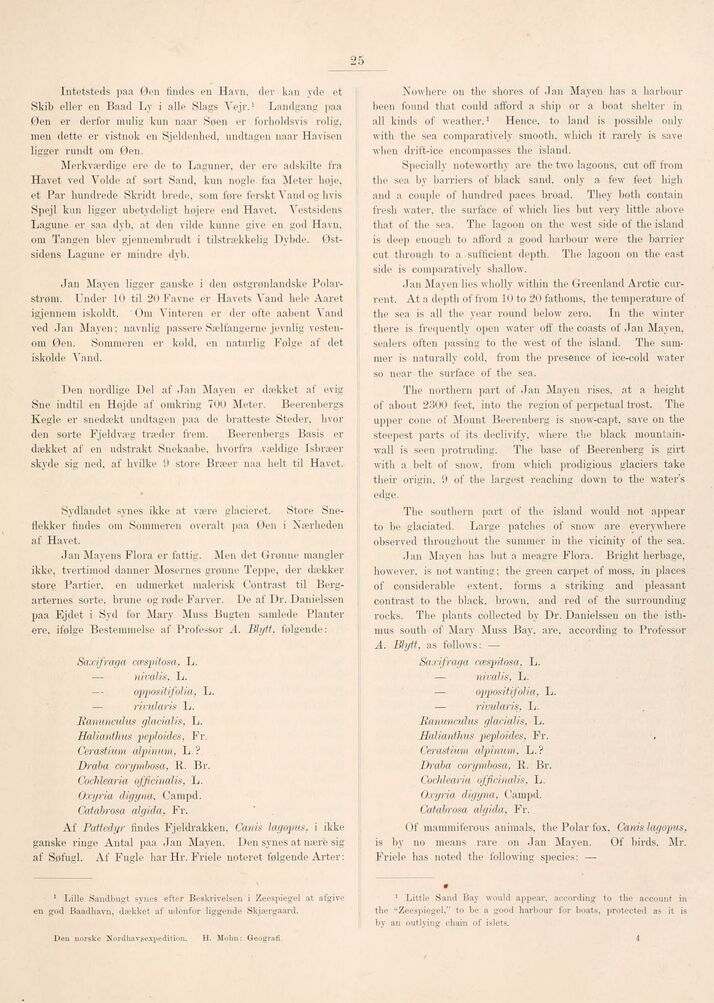
Full resolution (JPEG) - On this page / på denna sida - Sidor ...

<< prev. page << föreg. sida << >> nästa sida >> next page >>
Below is the raw OCR text
from the above scanned image.
Do you see an error? Proofread the page now!
Här nedan syns maskintolkade texten från faksimilbilden ovan.
Ser du något fel? Korrekturläs sidan nu!
This page has never been proofread. / Denna sida har aldrig korrekturlästs.
Intetsteds paa Øen findes en Havn. der kan yde et
Skib eller en Baad Ly i alle Slags Vejr.1 Landgang paa
Øen er derfor mulig kun naar Søen er forholdsvis rolig,
men dette er vistnok en Sjeldenhed, undtagen naar Havisen
ligger rundt om Øen.
Merkværdige ere de to Laguner, der ere adskilte fra
Havet ved Volde af sort Sand. kun nogle faa Meter høje,
et Par hundrede Skridt brede, som føre ferskt Vand og hvis
Spejl kun ligger ubetydeligt højere end Havet. Vestsidens
Lagune, er saa dyb. at den vilde kunne give en god Havn.
om Tangen blev gjennembrudt i tilstrækkelig Dybde.
Østsidens Lagune er mindre dyb.
Jan Maven ligger ganske i den østgrønlandske
Polarstrøm. Under 10 til 20 Favne er Havets Vand hele Aaret
igjennem iskoldt. Om Vinteren er der ofte aabent Vand
ved Jan Mayen; navnlig passere Sælfangerne jevnlig
vesten-om Øen. Sommeren er kold, en naturlig Følge af det
iskolde Vand.
Den nordlige Del af Jan Mayen er dækket af evig
Sne indtil en Højde af omkring 700 Meter. Beerenbergs
Kegle er snedækt undtagen paa de bratteste Steder, hvor
den sorte Fjeldvæg træder frem. Beerenbergs Basis er
dækket af en udstrakt Snekaabe, hvorfra -vældige Isbræer
skyde sig ned. af hvilke 9 store Bræer naa helt til Havet.
Sydlandet synes ikke at være glacieret. Store
Sne-flekker lindes om Sommeren overalt paa Øen i Nærheden
af Havet.
Jan Mavens Flora er fattig. Men det Grønne mangler
ikke, tvertimod danner Mosernes grønne Teppe, der dækker
store Partier, en udmerket malerisk Contrast til
Bergarternes sorte, brune og røde Farver. De af Dr. Danielssen
paa Ej det i Syd for Mary Muss Bugten samlede Planter
ere. ifølge Bestemmelse af Professor A. Blytt, følgende:
Saxifraga cæspitosa, L.
— nivalis, L.
— oppositifolia, L.
— rivularis L.
Ranunculus glacialt s, L.
Halianthus peploides, Fr.
Cerastium alpinum, L ?
Drdba corymbosa, R. Br.
Cochlearia officinalis. L.
Oxyria digyna. Campd.
Catdbrosa algida, Fr.
Af Pattedyr findes Fjeldrakken. Canis lagopus, i ikke
ganske ringe Antal paa Jan Maven. Den synes at nære sig
af Søfugl. Af Fugle har Hr. Friele noteret følgende Arter:
1 Lille Sandbugt synes efter Beskrivelsen i Zeespiegel at afgive
en god Baadhavn, dækket af udenfor liggende Skjær gaard.
Den norske Nordhavsexpedition. H. Mohn: Geografi.
Nowhere on the shores of Jan Mayen has a harbour
been found that could afford a ship or a boat shelter in
all kinds of weather.1 Hence, to land is possible only
with the sea comparatively smooth, which it rarely is save
when drift-ice encompasses the island.
Specially noteworthy are the two lagoons, cut off from
the sea by barriers of black sand, only a few feet high
and a couple of hundred paces broad. They both contain
fresh water, the surface of which lies but very little above
that of the sea. The lagoon on the west side of the island
is deep enough to afford a good harbour were the barrier
cut through to a sufficient depth. The lagoon on the east
side is comparatively shallow.
Jan Mayen lies wholly within the Greenland Arctic
current. At a depth of from 10 to 20 fathoms, the temperature of
the sea is all the year round below zero. In the winter
there is frequently open water off the coasts of Jan Mayen,
sealers often passing to the west of the island. The
summer is naturally cold. from the presence of ice-cold water
so near the surface of the sea.
The northern part of Jan Mayen rises, at a height
of about 2300 feet, into the region of perpetual trost. The
upper cone of Mount Beerenberg is snow-capt, save on the
steepest parts of its declivity, where the black
mountain-wall is seen protruding. The base of Beerenberg is girt
with a belt of snow, from which prodigious glaciers take
their origin, 9 of the largest reaching down to the water’s
edge.
The southern part of the island would not appear
to be glaciated. Large patches of snow are everywhere
observed throughout the summer in the vicinity of the sea.
Jan Mayen has but a meagre Flora. Bright herbage,
however, is not wanting; the green carpet of moss. in places
of considerable extent, forms a striking and pleasant
contrast to the black, brown, and red of the surrounding
rocks. The plants collected by Dr. Danielssen on the
isthmus south of Mary Muss Bay. are. according to Professor
A. Blytt, as follows: —
Saxifraga cæspitosa, L.
nivalis, L.
— oppositifolia, L.
— rivularis, L.
Ranunculus glacialis, L.
Halianthus peploides, Fr.
Cerastium alpinum, L.P
Draba corymbosa, R. Br.
Cochlearia officinalis, L.
Oxyria digyna. Campd.
Catabrosa algida, Fr.
Of mammiferous animals, the Polar fox. Canis lagopus,
is by no means rare on Jan Mayen. Of birds. Mr.
Friele has noted the following species: —
1 Little Sand Bay would appear, according to the account in
the "Zeespiegel," to be a good harbour for boats, protected as it is
by an outlying chain of islets.
4
<< prev. page << föreg. sida << >> nästa sida >> next page >>